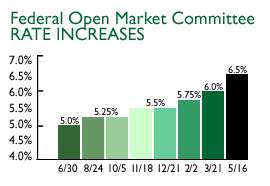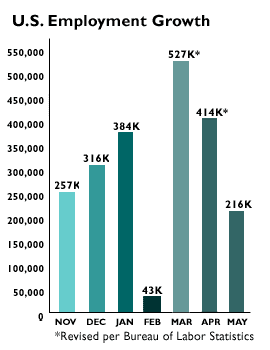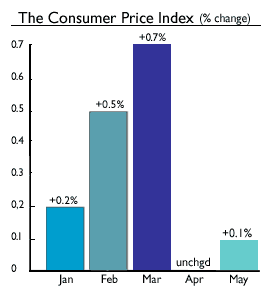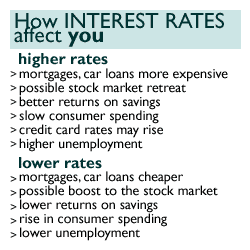|
Is the slowdown for real?
|
 |
June 26, 2000: 1:16 p.m. ET
Too good to be true, economists say, suggesting August rate hike imminent
By Staff Writer M. Corey Goldman
|
NEW YORK (CNNfn) - Is it too good to be true? Is the U.S. economy at long last finally beginning to downshift from its torrid pace and behave?
Most analysts don't think we're out of the woods just yet. Yes, retail sales slowed last month, yes, the jobless rate ticked up a notch and yes, manufacturing output has slowed. But it's way too soon to declare the battle against inflation over and done with so quickly, according to the experts.
 So far, with the exception of last month, the U.S. economy has shown remarkably little evidence of tiring, after more than nine years of uninterrupted expansion and six rate increases from the Federal Reserve over the past year. People are still spending, companies are still producing hefty profits and employers are still having a tough time finding skilled workers. The U.S. economy expanded at a 5.4 percent pace in the first three months of 2000. So far, with the exception of last month, the U.S. economy has shown remarkably little evidence of tiring, after more than nine years of uninterrupted expansion and six rate increases from the Federal Reserve over the past year. People are still spending, companies are still producing hefty profits and employers are still having a tough time finding skilled workers. The U.S. economy expanded at a 5.4 percent pace in the first three months of 2000.
At the same time, there are anecdotal signs that things are starting to cool off. Dot.com companies, for instance, have begun firing workers in the face of growing pressure to turn a profit, and sales of luxury items such as cars and vacations are beginning to taper off. That's left many on Wall Street skeptical and divided on whether Fed Chief Alan Greenspan can really accomplish a "soft landing" for the economy -- a slowdown that doesn't trigger a recession.
"The Fed is not necessarily finished with raising rates," Alan Blinder, a fellow with the Brookings Institution in Washington and former vice chairman of the Fed, told CNNfn.com. "They will want to see more evidence of slowing, both in the employment numbers and in other areas of the economy."
Taking out insurance
Blinder, who sat in the No. 2 spot beside Chairman Alan Greenspan from June 1994 through January 1996, said that the policy gurus who sit on the Fed's Open Market Committee likely will want to see more direct evidence that their handiwork is damping the progress of the economy before they all raise their hands and vote to lift rates again.
 The FOMC in mid-May raised its benchmark interest rate, the fed funds rate, by a half-point to 6.5 percent, the highest in nine years. The FOMC in mid-May raised its benchmark interest rate, the fed funds rate, by a half-point to 6.5 percent, the highest in nine years.
But that doesn't mean they won't move again, either at the conclusion of their two-day meeting on Wednesday or in August "as a little insurance measure," Blinder said. "They could easily adopt a wait-and-see approach and examine more of the economic data as it comes in, but I doubt highly that anyone who sits at that table is convinced right now that their job is done," he said.
Why? Because even with the recent signs of slowing, the U.S. economy still has a tremendous amount of juice.
A tight labor market
Take the job market. The economy actually shed 116,000 jobs last month, excluding Census-related hiring by the U.S. government, the first monthly decline in hiring in more than four years. Job losses were across the board, according to the Labor Department's monthly tally, with the gist of losses coming from the retail and consumer services sectors. But the unemployment rate still rests at a near-30-year low of 4.1 percent.
"If you look around and you'd hardly notice any kind of slackening in the labor market," said Wayne Ayers, chief economist with FleetBoston Financial. "I find it strange that we had one of the biggest declines in employment in almost two years and no one noticed, and I'm sure they're thinking the same way over there at the Fed."
 Other evidence points to the same thing. Retail sales have declined for two consecutive months, and sales of durable goods -- big-ticket items built to last at least three years -- have also begun to taper off. But sales are still up more than 7 percent from year-earlier levels. Manufacturing output and intentions among producers to boost production have slowed dramatically from their high levels, and the housing market, though off its peak, remains very robust. Other evidence points to the same thing. Retail sales have declined for two consecutive months, and sales of durable goods -- big-ticket items built to last at least three years -- have also begun to taper off. But sales are still up more than 7 percent from year-earlier levels. Manufacturing output and intentions among producers to boost production have slowed dramatically from their high levels, and the housing market, though off its peak, remains very robust.
And while overall inflation has remained extraordinarily tame in the past year, there is compelling evidence that prices for goods and services at the retail level are beginning to creep higher. Since May 1999, consumer prices have risen 3.1 percent; prices rose 2.7 percent for all of last year.
But, as economists love to say, one month does not a trend make.
"Inflation, on the surface, does not appear to be a concern, but it's obvious that prices for some items are rising," said Charles Lieberman, Chief Economist of First Institutional Securities. "It's inevitable that when people are armed with fatter paychecks and when companies are spending more to produce goods and services, prices are going to rise."
Prices are rising
And rise they have, in many instances. Food is more expensive. Cigarettes are more expensive. Transportation is more expensive. Gasoline is obviously more expensive. And maintenance costs on homes, including mortgage payments and general upkeep, have risen in line with rising interest rates at the nation's banks -- a direct result of the Fed's recent spate of rate hikes.
 On the flip side, there has been lots of anecdotal evidence that the heady days of 1999, when almost anyone with an idea and Web site domain name could get funding, has come to a sobering end, particularly in the job market. Companies such as APBNews.com, drkoop.com, Salon.com have been forced to fire workers or shut down altogether to meet profit objectives. On the flip side, there has been lots of anecdotal evidence that the heady days of 1999, when almost anyone with an idea and Web site domain name could get funding, has come to a sobering end, particularly in the job market. Companies such as APBNews.com, drkoop.com, Salon.com have been forced to fire workers or shut down altogether to meet profit objectives.
So what to make of it? Warren Bailey, a professor of economics with Cornell University, believes that the U.S. economy needs more short-term pain for long-term gain -- pain in the form of higher borrowing costs for consumers and businesses, pain in the form of more muted returns on companies that stand to make less profit and pain in the form of more subdued consumer spending.
"You want to grow as fast as possible, but when you do that the ups and downs are huge," Bailey said. "If the government contracts the economy in advance in a mild way, that makes those ups and downs less onerous, and spares us a lot more pain down the road. That's why they're raising rates."
The catch 22
Most analysts expect the Fed will take a pass at its meeting this week, choosing to wait it out for more numbers before deciding whether they need to continue with their battle at keeping inflation subdued.
 A big quandary for the Fed has been, and still is, the stock market. Both the Dow Jones industrial average and the Nasdaq composite index have all but recovered their steep losses suffered this past spring as investors regain their faith in the ability of companies to produce profits, and on expectations that the Fed's series of rate increases are coming to an end. A big quandary for the Fed has been, and still is, the stock market. Both the Dow Jones industrial average and the Nasdaq composite index have all but recovered their steep losses suffered this past spring as investors regain their faith in the ability of companies to produce profits, and on expectations that the Fed's series of rate increases are coming to an end.
But that in and of itself could alter the Fed's decision on future rate increases. Until the stocks took their precipitous dive back in late February and early March, Greenspan & Co. had spent a lot of time discussing the so-called wealth effect, where rising stock values give consumers confidence to spend money, even though their holdings aren't necessarily in cash.
"From the Fed's point of view we've had head-fakes before -- I think they want to see a more stable environment for financial markets before they call it a day," Ayers said. "I don't expect that's going to happen overnight. We will see a sustainable slowdown, but it may not happen right away." 
|
|
|
|
|
|
U.S. Federal Reserve
|
Note: Pages will open in a new browser window
External sites are not endorsed by CNNmoney
|
|
|
|
 |

|

